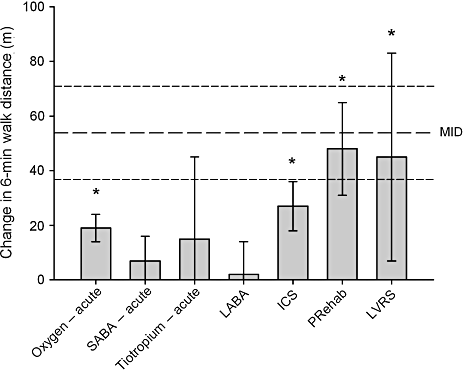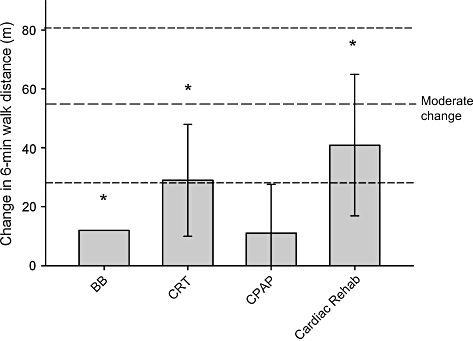The six-minute walk test: a useful metric for the cardiopulmonary patient
Funding: None.
Conflict of interest: None.
Abstract
Measurement of exercise capacity is an integral element in assessment of patients with cardiopulmonary disease. The 6-min walk test (6MWT) provides information regarding functional capacity, response to therapy and prognosis across a range of chronic cardiopulmonary conditions. A distance less than 350 m is associated with increased mortality in chronic obstructive pulmonary disease, chronic heart failure and pulmonary arterial hypertension. Desaturation during a 6MWT is an important prognostic indicator for patients with interstitial lung disease. The 6MWT is sensitive to commonly used therapies in chronic obstructive pulmonary disease such as pulmonary rehabilitation, oxygen, long-term use of inhaled corticosteroids and lung volume reduction surgery. However, it appears less reliable to detect changes in clinical status associated with medical therapies for heart failure. A change in walking distance of more than 50 m is clinically significant in most disease states. When interpreting the results of a 6MWT, consideration should be given to choice of predictive values and the methods by which the test was carried out.
Introduction
Exercise intolerance is a cardinal feature of cardiopulmonary diseases including chronic obstructive pulmonary disease (COPD), heart failure, interstitial lung disease and pulmonary arterial hypertension. Exercise testing is frequently used to assist clinicians in assessing prognosis and evaluating response to treatment. The 6-min walk test (6MWT) is a standardized test of functional exercise capacity, which is increasingly used to assess mobility in older persons1 and as a primary end-point for important research studies in cardiopulmonary diseases.2–4 It is therefore timely to consider how the 6MWT may assist physicians in clinical decision-making.
The test involves walking back and forth along a flat straight course for 6 min adhering to a standardized protocol.5 It is self-paced (in contrast to incremental tests such as the shuttle walk test, in which patients are required to keep pace with external cues), is simple to perform, and is reproducible and inexpensive. Measured variables are distance walked in 6 min (6MWD) and symptoms, as well as oxyhaemoglobin saturation and heart rate where appropriate.
The 6MWT provides a valid assessment of functional performance in persons with chronic cardiopulmonary disorders and can be carried out across the clinical spectrum of disease.6 Because the 6MWD is influenced by musculoskeletal and volitional factors as well as underlying cardiopulmonary pathology, it provides a global assessment of exercise capacity and may better reflect daily activity than laboratory tests.5 Given its safety profile, based on thousands of elderly patients tested without complications, physician attendance is not required.1 However, the test should be supervised by an experienced clinician (e.g. nurse or physiotherapist) who has had training in cardiopulmonary resuscitation and should be conducted in a setting where a rapid response to an emergency is possible.5 The purpose of this review is to synthesize the available published work regarding the clinical interpretation of the 6MWT in adults with cardiopulmonary disease.
Methods
A search for English language publications on the 6MWT was carried out using Medline, Embase and CINHAL. The search terms were 6-minute walk test, 6MWD and six-minute walk, including hyphenated variants. Identified articles were included where they pertained to the measurement properties; predicted values; the relationship of 6MWD to impairment and prognosis; or where the 6MWT was an outcome for a randomized controlled trial.
What is a ‘normal’ 6MWD?
Age, sex, height, weight, FEV1 and ethnicity are important determinants of an individual's 6MWD.7–11 In general, men walk further than women and distance walked declines with increasing age. A variety of equations is available to predict 6MWD, but there is some variation in the expected distance (Table 1). Several factors may contribute to this variation. Most studies have been undertaken in white populations and these equations may not be suitable for predicting walking distance in non-white populations.10 The studies frequently use convenience samples8,9,11 and may not be representative of population characteristics. The testing procedure varies between studies and this may also affect distance. Finally, the variance in walking distance that can be explained by the prediction equations varies from 2011 to 78%,10 suggesting that there may be other, as yet unknown factors that also affect the 6MWD.
| Reference | Study group | Predictors of walking distance | Predicted 6MWD (m) | |
|---|---|---|---|---|
| Male | Female | |||
| Camarri et al.7 | Healthy adults, 55–75 years, n = 70 | Height, age, weight, sex | 743 | 665 |
| Gibbons et al.8 | Healthy adults, 20–80 years, n = 86 | Age, sex | 689 | 615 |
| Troosters et al.9 | Healthy adults, 50–85 years, n = 51 | Height, age, weight, sex | 656 | 554 |
| Enright and Sherrill11 | Healthy adults, 40–80 years, n = 253 | Height, age, weight | 578 | 502 |
| Poh et al.10 | Healthy Singaporean adults, 45–85 years, n = 35 | Height, age, weight, %predHRmax | 610 | 555 |
- † Predicted values for men are based on weight = 82 kg and height = 176 cm; women weight = 70 kg height = 162 cm; and mean %predHRmax of 122 b.p.m.10 6MWD, 6-min walk distance. %predHRmax, percentage of predicted maximum heart rate achieved on the 6-min walk test.
Interpreting change in the 6MWT
Interpreting a change in 6MWD requires knowledge of the threshold at which an observed difference in walking distance will be perceived as important to the patient, referred to as the minimal important difference (MID). The MID for the 6MWT in patients with COPD has been defined as a difference of 54 m (95% confidence interval 37–71 m).12 This distance was determined in a cross-sectional study where 112 subjects were asked to make subjective comparison of their walking ability with that of others. This cross-sectional approach has methodological limitations as the meaning of between-person differences may not be the same as within-person differences over time.13
Two studies have evaluated meaningful change in the 6MWD using longitudinal methods focused on change within individuals. The improvement in walking distance associated with small meaningful change for community dwelling older persons was 20 m, whereas an increase of 50 m indicated substantial change.14 In patients with heart failure and a left ventricular ejection fraction (LVEF) less than 40%, the mean change in walking distance associated with moderate improvement was 55 m.15 No estimate of small meaningful change is possible from this study.
To date, there has been little investigation of the MID for the 6MWD in other diseases and a threshold of 54 m has been widely accepted as representative of clinically significant change. It should be noted that this threshold was calculated based on the ‘average’ patient and may not be applicable to every individual.12 However, the 6MWD is a sensitive marker of change after many interventions, as attested by its widespread use as an outcome of clinical trials.
Chronic obstructive pulmonary disease
The average 6MWD in patients with moderate to severe COPD is 238–388 m with a wide range of 160–600 m.16,17 A shorter 6MWD (≤367 m) is associated with an increased risk of hospital admission.18 However, the 6MWD does not have a strong relationship with airflow obstruction, exertional dyspnoea or health-related quality of life.19
Longitudinal data suggest that the 6MWD declines over time. Over a period of 5 years in patients with stage III COPD (FEV1 30–50% predicted) the 6MWD declined by 19% (an average of 16 m per year) and by 26% in patients with stage IV COPD (FEV1 <30% predicted).16 The 6MWD is a strong predictor of mortality (Table 2) and deterioration in 6MWD is independent of decline in FEV1.17 In those with advanced COPD for whom lung volume reduction surgery (LVRS) is an option, a 6MWD before surgery of <200 m is associated with an unfavourable outcome.29
| Patient Group | Author | Patient characteristics | Timepoint (months) | Threshold distance (m) | Risk of mortality |
|---|---|---|---|---|---|
| COPD | Pinto-Plata et al. (2004)17 | Severe COPD, n = 198 | 23 | 100 | 85%; ↑18% for every ↓50 m |
| Cote et al. (2008)20 | Moderate to severe COPD, n = 1379 | 55 | 350 | 66% | |
| Interstitial lung disease | Lederer et al. (2006)21 | IPF listed for lung transplantation, n = 454 | 6 | 207 | 40% |
| Kawut (2005)22 | DPLD referred for transplant assessment, n = 51 | 12 | 350 | 67% | |
| Pulmonary arterial hypertension | Miyamoto et al. (2000)23 | Idiopathic PAH, on treatment, n = 43 | 21 | 332 | 80% |
| Provencher et al. (2006)24 | Idiopathic PAH, treated with bosentan, n = 103 | 12 | 378 | 15% | |
| Patients awaiting transplantation | Kadikar et al. (1997)25 | COPD, IPF, PAH, cystic fibrosis, n = 154 | NR | 400 | NR |
| Congestive heart failure | Zugck et al. (2000)26 | LVEF ≤ 35%, n = 113 | 12 | 300 | 57% |
| Rostagno et al. (2003)27 | Mild to moderate CHF, n = 214 | 36 | 300 | 38% | |
| Passantino et al. (2006)28 | LVEF 30%, n = 476 | 24 | 340 | ↑3.5 risk of death |
- CHF, congestive heart failure; COPD, chronic obstructive pulmonary disease; DPLD, diffuse parenchymal lung disease; IPF, idiopathic pulmonary fibrosis; LVEF, left ventricular ejection fraction; NR, not reported; PAH, pulmonary arterial hypertension.
Statistically significant improvements in 6MWD may be seen after the acute administration of oxygen, long-term administration of inhaled corticosteroids, pulmonary rehabilitation and LVRS (Fig. 1). Although the mean change following many treatments does not achieve the MID of 54 m, most exceed the lower limit of the 95% confidence interval. The 6MWD may not be responsive to acute changes in physiology with inhaled therapies.

Change in 6-min walk distance with common treatments in COPD from randomized controlled trials. Data are mean difference between groups and 95% confidence intervals. *P < 0.05 versus control. Dotted lines indicate minimal important difference (MID) and its 95% confidence interval.12 References (left to right in the x-axis).3,30–35 ICS, inhaled corticosteroids; LABA, long-acting beta agonist; LVRS, lung volume reduction surgery; PRehab, Pulmonary Rehabilitation; SABA, short-acting beta agonist.
Heart failure
The average 6MWD in persons with heart failure ranges from 310 m in those with a LVEF of 20%36 up to 427 m in those with mild disease (LVEF 53%).27 The 6MWD has an inverse relationship with New York Heart Association (NYHA) functional class and a weak inverse correlation with quality of life.37,38 The 6MWD is strongly correlated to VO2peak, which is an important marker of prognosis and timing of heart transplantation in this population.26
Several authors have reported that a 6MWD of less than 300 m is a strong indicator of increased mortality (Table 2). However, others have not confirmed this relationship and suggest that VO2peak is a better predictor of survival, particularly over longer time periods.36,39 It is possible that the 6MWD provides useful prognostic information for patients with mild to moderate disease; however, maximal exercise testing may be more informative in those with severe heart failure who are referred for heart transplantation.
The 6MWD may not be a sensitive marker of change following medical therapy for heart failure (Fig. 2). Treatment with beta-blockers may not substantially improve 6MWD despite improvements in LVEF and NHYA functional class.4,43 Similarly, angiotensin II blockers and ACE inhibiters do not appear to enhance 6MWD.44 A decrease in 6MWD (mean 41 m) has been documented on withdrawal of digoxin in patients with LVEF ≤35%45 and small but significant improvements in 6MWD have been documented trials of cardiac resynchronization therapy40 and continuous positive airway pressure.41 Clearer effects on functional exercise capacity are seen after cardiac rehabilitation.42

Change in 6-min walk distance with common treatments in heart failure from randomized controlled trials. BB, beta-adrenergic blockers; CPAP, continuous positive airway pressure; CRT, cardiac resynchronisation therapy. Data are mean difference between groups and 95% confidence intervals (confidence intervals not reported for BB), with exception of CRT data, which is median difference. *P < 0.05 versus control. Dotted lines show moderate change and its 95% confidence interval.15 References (left to right).4,40–42
Pulmonary arterial hypertension
An average 6MWD of 297 m has been reported in patients with idiopathic pulmonary arterial hypertension (idiopathic PAH) with mean age 37 years who were undergoing treatment, compared with 655 m in a group of age-matched controls.23 This indicates very severe impairment of functional walking capacity in a relatively young patient group. Shorter walking distances are significantly related to lower NHYA/World Health Organization functional class and lower VO2peak.23 Those patients with lower 6MWD also have impaired skeletal muscle strength46 and markedly impaired health-related quality of life.47 The 6MWD is independently related to mortality in patients who are on treatment, with those patients who achieve a threshold of 378 m having improved survival irrespective of their baseline 6WMD.24 This relationship between walk distance and mortality is not seen in patients with untreated PAH, where desaturation during the 6MWD provides a better predictor of walk distance – for every per cent decrease in SpO2 on 6MWT there is a 26% increase in risk of death.48
The 6MWD is commonly used to evaluate response to specific pharmacological treatments in PAH. Clinically important improvements in walking distance (44–76 m) have been reported after treatment with the new selective pulmonary vasodilator bosentan.49,50 Improvements of a similar magnitude have been reported following treatment with inhaled iloprost51 or sildenafil.52 Because of its sensitivity, the 6MWD is commonly undertaken in clinical practice to monitor response to therapy in persons with PAH. In Australia, the 6MWD forms part of the required assessment for government-funded bosentan, iloprost, sildenafil, prostacyclin and sitaxsentan. Changes in walking distance are difficult to detect in patients with a baseline 6MWD of greater than 450 m.53
Interstitial lung disease
The average 6MWD in patients with moderately severe interstitial lung disease (diffusing capacity for carbon monoxide (DLCO) 49% predicted) is reported to be 415 m, with a wide range of 96–681 m.54 The 6MWD is strongly correlated to maximum exercise capacity in idiopathic pulmonary fibrosis, with shorter walking distances associated with a lower VO2 peak.55 Shorter walking distances are also strongly associated with important clinical markers such as reduced diffusing capacity, reduction in forced vital capacity, higher levels of pulmonary hypertension and diminished quality of life.21,54–56
Oxygen desaturation during the 6MWT is an important prognostic marker in patients with idiopathic pulmonary fibrosis. Those who desaturate to ≤88% have a significantly higher mortality than those who do not desaturate, with a fourfold higher hazard of dying during 3 years of follow up.57 In patients with severe idiopathic pulmonary fibrosis who are awaiting lung transplantation, a 6MWD of less than 207 m is associated with a fourfold increase in mortality rate;21 however, other authors have not found a relationship between distance walked and mortality in patients who were not awaiting transplantation.57,58
There are few treatments that have shown improvements in functional status for persons with interstitial lung disease and therefore changes in 6MWD may be difficult to detect. In patients with idiopathic pulmonary fibrosis there was no effect of bosentan on 6MWD after 12 months despite improvements in quality of life and trends towards reduced progression of disease.2 Small but significant gains in 6MWD have been reported following pulmonary rehabilitation in a group of 57 patients with interstitial lung disease, 30 of whom had idiopathic pulmonary fibrosis.59 It is possible that the magnitude of desaturation during the 6MWT is a more sensitive marker of clinical improvement following treatment in this population.60
Limitations of the 6MWT
A weakness of the 6MWT is that it provides little information regarding the mechanism of exercise limitation and thus cannot aid in diagnosis. Cardiopulmonary exercise testing will give greater information regarding the organs or systems contributing to reduced exercise tolerance. Although the only absolute contraindications to 6MWT are unstable angina and myocardial infarction in the last month, those patients who report significant exercise-related symptoms (e.g. syncope) may be better assessed using a cardiopulmonary exercise test where more extensive monitoring is available.5
As the 6MWT is self-paced, there is potential for motivational factors to have a large influence on performance. However, with an appropriately standardized method the 6MWD is highly reproducible. By contrast, inter-test variation in oxygen desaturation is high, suggesting that treatment decisions should not be based on a single measure of exertional desaturation recorded on 6MWT.55
Although the 6MWD is a sensitive marker of change in functional walking ability for patients with moderate to severe disease, its use in those with better-preserved exercise tolerance is unclear. A ceiling effect has been documented in patients with PAH whose 6MWD is greater than 450 m and this may also occur in patients with other conditions.53 Consideration should be given to use of a more challenging test of exercise capacity in these patients, such as a cardiopulmonary exercise test or an incremental shuttle walking test.
How can the 6MWT aid patient care?
Once a diagnosis is established, the 6MWT provides an excellent tool for ongoing monitoring of patients with cardiopulmonary disease. For physicians, the 6MWD can be used to assess the extent of functional exercise limitation by comparison to appropriately selected reference values (Table 1). Distance walked can also give a reliable indicator of whether new therapies have affected functional performance – changes in the 6MWD in excess of 50 m indicate substantial and clinically significant change in walking capacity has occurred, irrespective of diagnosis or treatment.12,14,15 Yearly monitoring of the 6MWD provides a useful indicator of disease progression and comparison can be made to disease-specific thresholds associated with increased mortality. A distance of less than 350 m is predictive of increased mortality across cardiopulmonary disorders (Table 2). Changes in treatment may result in improved outcome for those whose 6MWD improves beyond the threshold distance.24
Conclusion
The 6MWT is a widely used measure of functional exercise capacity in persons with cardiopulmonary disease. The distance walked provides a simple assessment of functional status and prognosis, with well-documented thresholds for increased mortality. There is some uncertainty regarding the magnitude of clinically significant improvement in the 6MWD, particularly outside the group of patients with COPD. However, with appropriate attention to standardization of the testing protocol, the 6MWD can provide a sensitive indicator of clinical change in most common cardiopulmonary conditions.




